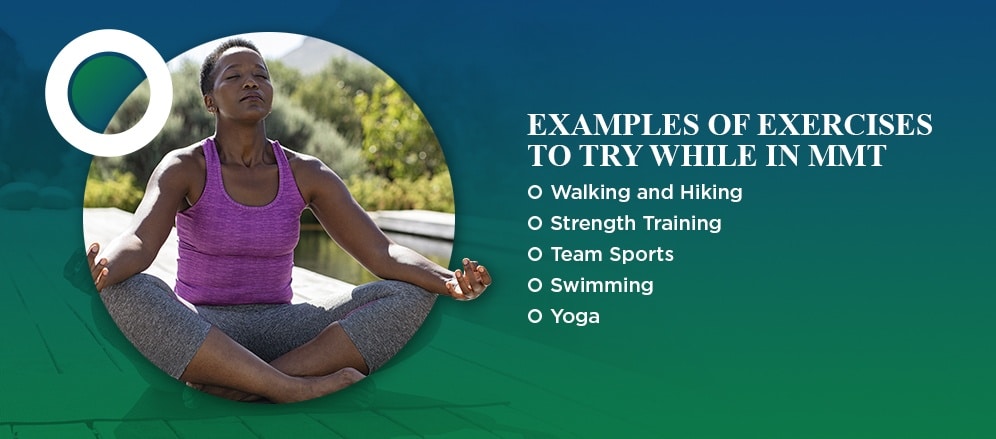Exercise is essential to a healthy lifestyle, and most of us don’t get enough of it. The U.S. Department of Health and Human Services recommends that adults get at least 150 to 300 minutes of moderate-intensity exercise or 75 to 150 minutes of vigorous-intensity activity per week for the most significant benefits. Exercise is even more critical for people in methadone maintenance treatment (MMT), as opioid addiction causes significant physical deterioration over time. We’ll explore the known advantages of exercise for people in MMT and provide some examples of rewarding exercises to try for improving overall physical and mental well-being.
Why Exercise Is Crucial for Those in MMT
A groundbreaking study in the Journal of Substance Abuse Treatment provides some insight into how essential exercise is for this demographic. The study evaluated 305 MMT patients from nine different locations in New England. The participants had been participating in their MMT programs for four weeks or more. These are some of the defining characteristics of the group:
- Average age of 40
- A 50/50 split between men and women
- A racial makeup of 80% non-Hispanic white individuals
- An average methadone dosage of 109 mg/day
Notably, nearly 45% of participants considered themselves to be in fair or poor physical health.
Study Results
Few of the participants met or surpassed the recommended exercise guidelines. Only 38% met the criteria, while nearly 25% said they got no physical activity at all. In comparison, around 49% of adults in the general population met guidelines at the time of the study, and only around 14% were inactive as defined by getting less than 10 minutes of moderate-intensity exercise each week.
At the end of the study, the majority of participants expressed a favorable view of the benefits of exercise for their recovery. More than three-quarters said exercise had the following effects on them:
- Producing a sense of accomplishment
- Improving health
- Increasing energy levels
- Feeling stronger
- Improving cardiovascular health
- Becoming more fit
- Losing or maintaining weight
The most significant benefit participants reported was that exercise increased their confidence in their ability to remain clean and sober. The participants who met exercise guidelines were much more likely to experience reduced anxiety than those who didn’t. They were also less likely to relapse.
Motivation Is a Must for MMT Patients
Motivation is a central challenge for people participating in methadone maintenance. Attending a clinic daily and committing to counseling services takes dedication that can sometimes wane as time goes on. The need for motivation in maintaining a regular exercise regimen is similar. Just over a third of the participants cited a lack of enthusiasm as the primary barrier to exercise, but some factors can remove or minimize this barrier.
The study authors noted that one way to enhance the desire to exercise is to employ short counseling sessions or interventions where the provider essentially “prescribes” exercise to the patients.

Examples of Exercises to Try While in MMT
What are the best types of physical activity for methadone treatment? There is no one-size-fits-all solution, and it’s generally best to employ a mixture of different activities. These are some of the most common and accessible ways to get more physical activity during MMT.
Walking and Hiking
For people just starting with an exercise routine, the simple act of taking a walk and getting some fresh air can reduce cravings. One study indicates that only 15 minutes of brisk walking can reduce the urge to drink among people who regularly consume large amounts of alcohol. If walking doesn’t provide enough stimulation or someone wants a greater challenge, hiking is a great way to get the heart rate up.
Strength Training
Cardio exercises tend to get most of the spotlight when it comes to exercise in recovery, but strength training is highly beneficial, as well. In addition to providing many of the same benefits as cardio, weightlifting and other associated training methods have psychological benefits associated with gaining strength. MMT patients can start strength training through a gym, or can start slowly with at-home equipment like dumbbells or resistance bands.
Team Sports
Sports like basketball, soccer and football are excellent options. They require mental focus, promote socialization and make it fun to get vigorous-intensity exercise. The minimal equipment needed also makes these sports easy to access.
Swimming
Swimming is an outstanding form of exercise for those who want to minimize the impact on their bones and joints. An hour of swimming can burn nearly as many calories as an hour of running. Many people also find that swimming is a calming, meditative experience.
Yoga
While yoga does not meet the criteria for aerobic exercise, it can still be a highly beneficial form of activity. It can lower the risk of heart disease and hypertension, while also reducing symptoms of depression. It can also be part of a mindfulness practice, making it very versatile for people in recovery.
Advantages of Physical Activity for the Body
Here is how patient exercise during methadone maintenance treatment can benefit the body.
- Weight control: People in recovery often find they gain weight once they are no longer abusing drugs. Exercise is essential in keeping weight at a healthy level.
- Reduced cravings: Physical activity helps take the mind off cravings, and helps reduce the severity of these urges when they do occur by minimizing the symptoms of depression and anxiety.
- Improved brain function: Enhanced blood flow from exercise stimulates the brain to produce chemicals that facilitate learning, cognition and better mood.
- Stronger bones and muscles: Exercise helps maintain muscle mass and slows down the bone loss associated with aging.
- Improved sleep quality: Moderate to vigorous exercise tires out the body in a way that promotes better sleep. People who exercise tend to fall asleep faster and stay asleep for longer.
- Longevity: Regular physical activity can reduce the risk of early death from several conditions, including heart disease and cancer.
- More robust immune system: Exercise can boost the defenses of the immune system, which is crucial to healing the damage that comes with chronic drug use.
Overall, getting regular exercise results in a healthier body and is a pivotal element in strengthening the mind. The relationship between exercise and methadone treatment is a positive one if patients can stay motivated.
A Foundation for Recovery at BAART Programs
If you are interested in MMT for recovery from opioid addiction, BAART Programs is ready to provide the care you need. Our comprehensive continuum of care goes beyond medication to behavioral health care and even integrated primary care in some locations, so you can get the support you need to remain clean and sober. Find a BAART location near you or contact us for more information on treatment.




